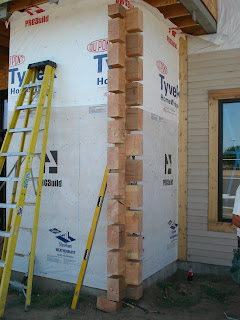


 We have lots of things that can be considered 'icons' of the Museum. Our "curb appeal" icons include the covered wagon and tipi on the lawn closest to Myra Road qualify. We often refer to our 33-mule team, Shandoney hitch, and wooden Harris combine in Exhibit Hall 3 as stars of the show, and our life-size Lewis & Clark diorama, currently on view in Headquareters as it awaits a new backdrop mural to be installed in the new Entrance building. By the way, local artist Leslie Cain has been commissioned to do the new mural.
We have lots of things that can be considered 'icons' of the Museum. Our "curb appeal" icons include the covered wagon and tipi on the lawn closest to Myra Road qualify. We often refer to our 33-mule team, Shandoney hitch, and wooden Harris combine in Exhibit Hall 3 as stars of the show, and our life-size Lewis & Clark diorama, currently on view in Headquareters as it awaits a new backdrop mural to be installed in the new Entrance building. By the way, local artist Leslie Cain has been commissioned to do the new mural.Various things on display obviously please some folks more than others, but a perennial favorite is the Territorial Prison display in Exhibit hall 5. As you walk through the old firehouse doors and past the circa 1900 American LaFrance fire engine, you'll see an actual pair of cells and the locking mechanism used to maintain security.
Many folks ... especially kids ... seem to like to take photos of their friends and family 'in stir.' In the letters we get from participants in our school tours, boys are inclined to pick the jail as their favorite display on the grounds. Boys, of course, will be boys.
In these warm days, consider the life of a prisoner. The cells are small and were occupied by at least two men. In the days before modern plumbing, restroom facilities consisted of a chamber pot: a bucket with a removable lid. This arrangement was emptied once a day by the prisoners. One can imagine the aroma building on a day such as this.
Next to the cells is a bit of the history of the prison and includes a selection of home-made weapons designed and crafted by the prisoners ... before they were confiscated.
Building Progress Report: Two steps forward, one step back ... I was once told that a couple building a home could expect enough stress in the building process to test the vialbility of their marriage. Well, we aren't married to the contractors, but you see the point, I'm sure. The lovely wood-look being applied to the exterior of the blockhouse entry did not meet the architect's specifications. To that end, we are trying our best to keep our new building from looking so much like a new building. When you consider that we are trying to enmulate an old fort, that makes sense ... the idea of trying to make the building appear as if it's already had a long life with lots of use.
Today's fotos, from the top: Washington State Penitentiary employee Alan Walter portrayed first Warden Frank Paine in the Living History Company ... that's him by the jail cells; Walla Walla Fire Department Captain Greg Van Donge portrays Walla Walla's first professional fireman Robert Wolf in the Living History Company, standing beside the American LaFrance pumper; an employee of Jim's Glass Copany repairs some broken glass on the firehouse doors from a windstorm in November, 2007. The doors are from the old station #4 that was on Rose Street, where the parking lot behind the City Building stands; a closer-up of the wood-look/no luck situation with the entry.


















-Katherine+Cordy-Kamika+Shaw_3.27.07.JPG)









